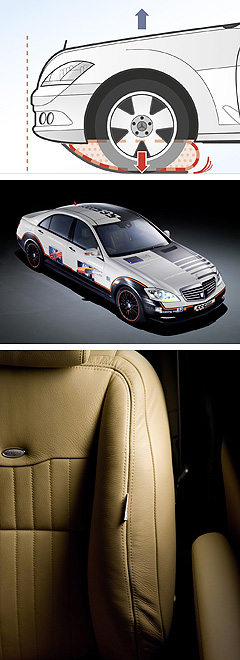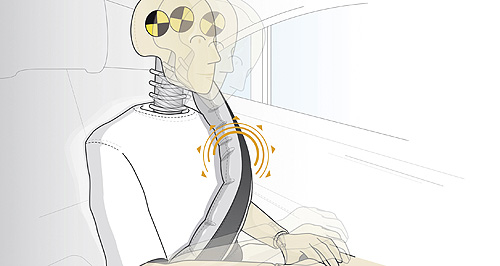Make / Model Search
Future models - Mercedes-Benz - S-ClassMercedes, the back belt championExplosive news: Mercedes-Benz’s innovative inflatable seatbelt helps to reduce crash impact on the chest of rear-seat passengers. Inflatable rear-seat ‘beltbags’ set to make debut in Mercedes S-Class limo next year23 Jul 2012 MERCEDES-BENZ has confirmed it will put its ground-breaking inflatable “beltbag” into production in a high-end luxury model, thought to be the new-generation flagship S-Class due next year. The rear-seat safety device is set to make its debut in developing markets such as China, which have high back-seat usage in chauffeur-driven limos and where Mercedes-Benz sells 60 per cent of its vehicles. Ultimately, the technology might be extended to markets such as Australia, where the all-new S-Class is set to arrive in showrooms in late 2013. The beltbag is worn like a normal seatbelt, but expands to almost three times the normal width when triggered by crash sensors in the front of the vehicle. The wider surface area of the inflated belt helps to reduce the risk of seat-belt injury by spreading the load and thus reducing chest deformation in a severe crash. The belts are inflated in the same way as an airbag, with an explosive “gas generator” mounted at the top end of the belt, and will be used in conjunction with Mercedes’ active seatbelt buckle that retracts into the seat to reduce the risk of pelvic injury.  From top: Mercedes-Benz braking bag Experimental Safety Vehicle inflating seat bolster. From top: Mercedes-Benz braking bag Experimental Safety Vehicle inflating seat bolster.The belt is folded and held together with Velcro until inflated. The beltbag was one of 27 patented safety devices packed into Mercedes’ 2009 ESF (Experimental Safety Vehicle) test vehicle that Mercedes-Benz Australia showed off in Melbourne in 2010. Other ESF technologies that are yet to make it into production include an underbody airbag that jams into the road surface to double braking force the moment before a crash, side impact bars that inflate like steel airbags in the doors to cushion collision forces and seats that move occupants away from the doors milliseconds before impact. Mercedes has not specifically named the Mercedes S-Class as the first vehicle to get the beltbag, saying only “a luxury-class model” will be the first to get the innovation. However, Mercedes has a tradition of introducing such safety features in its big sedan before filtering them down the range and across markets. Likewise, Mercedes has not named China as the debut market, but the global Mercedes press release announcing the move indicates that this is the main target for the device. “The beltbag was developed with a particular view toward new markets,” says the release. “There, the occupancy rate in the rear is as much as 30 per cent, making it much higher than in Europe.” Mercedes-Benz Cars’ head of passive safety and vehicle functions, Rodolfo Schoneburg, said Mercedes safety standards did not only apply to all models, but to all seats. However, the beltbag has been designed specifically for rear-seat passengers, where conventional frontal airbags are difficult to install. The seatbelts in the rear seats of Mercedes cars already are equipped with pre-tensioners and force limiters – features that are confined to the front belts of most other cars. Mercedes says that, because conventional crash-test dummies could not measure the extra protection afforded by the inflatable seatbelt, it has developed computer-based “virtual human models”. “Computer-generated models make it possible to obtain detailed findings on the biomechanical strain during a collision,” Mercedes says. Because the beltbag is bulkier than a conventional seatbelt due to its multiple folded layers, Mercedes put effort into making it comfortable to wear by giving it soft edges.  Read moreAll future models Alfa Romeo Alfa Romeo Abarth Abarth Alpine Alpine Alpina Alpina Audi Audi Aston Martin Aston Martin BMW BMW Bentley Bentley Chery Chery Brabham Brabham Chrysler Chrysler Chevrolet Chevrolet Cupra Cupra Citroen Citroen DS DS Dodge Dodge Fiat Fiat Ferrari Ferrari Foton Foton Ford Ford Great Wall Great Wall FPV FPV Haval Haval GWM GWM Honda Honda Holden Holden Hummer Hummer HSV HSV Infiniti Infiniti Hyundai Hyundai Jaguar Jaguar Isuzu Isuzu Kia Kia Jeep Jeep Land Rover Land Rover Lamborghini Lamborghini Lexus Lexus LDV LDV Mahindra Mahindra Lotus Lotus Mazda Mazda Maserati Maserati Mercedes-AMG Mercedes-AMG McLaren McLaren MG MG Mercedes-Benz Mercedes-Benz Mitsubishi Mitsubishi Mini Mini Opel Opel Nissan Nissan Peugeot Peugeot Pagani Pagani Proton Proton Porsche Porsche Renault Renault Ram Ram Rover Rover Rolls-Royce Rolls-Royce Skoda Skoda Saab Saab SsangYong SsangYong Smart Smart Suzuki Suzuki Subaru Subaru Toyota Toyota Tesla Tesla Volvo VolvoS-Class pricing
Motor industry news |
Click to shareMercedes-Benz modelsAll future models Alfa Romeo Alfa Romeo Abarth Abarth Alpine Alpine Alpina Alpina Audi Audi Aston Martin Aston Martin BMW BMW Bentley Bentley Chery Chery Brabham Brabham Chrysler Chrysler Chevrolet Chevrolet Cupra Cupra Citroen Citroen DS DS Dodge Dodge Fiat Fiat Ferrari Ferrari Foton Foton Ford Ford Great Wall Great Wall FPV FPV Haval Haval GWM GWM Honda Honda Holden Holden Hummer Hummer HSV HSV Infiniti Infiniti Hyundai Hyundai Jaguar Jaguar Isuzu Isuzu Kia Kia Jeep Jeep Land Rover Land Rover Lamborghini Lamborghini Lexus Lexus LDV LDV Mahindra Mahindra Lotus Lotus Mazda Mazda Maserati Maserati Mercedes-AMG Mercedes-AMG McLaren McLaren MG MG Mercedes-Benz Mercedes-Benz Mitsubishi Mitsubishi Mini Mini Opel Opel Nissan Nissan Peugeot Peugeot Pagani Pagani Proton Proton Porsche Porsche Renault Renault Ram Ram Rover Rover Rolls-Royce Rolls-Royce Skoda Skoda Saab Saab SsangYong SsangYong Smart Smart Suzuki Suzuki Subaru Subaru Toyota Toyota Tesla Tesla Volvo VolvoS-Class pricing
Motor industry news |










Facebook Twitter Instagram